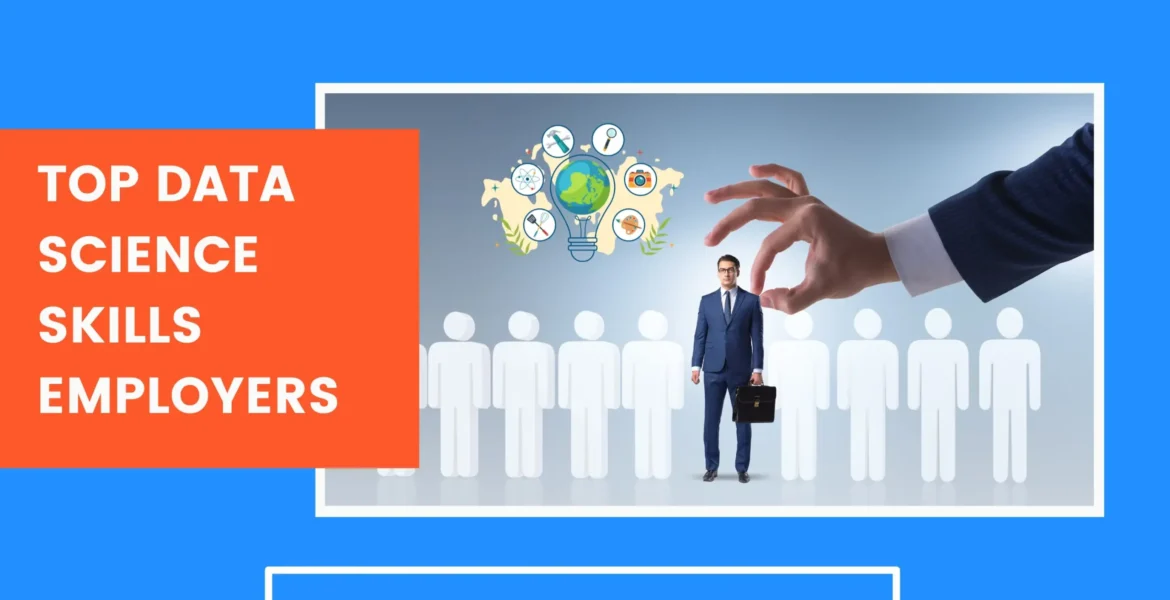Top Data Science Skills Employers are Looking for in 2024
Education has always been one of the mainstays of our society, providing both knowledge for individual minds and a prop to personal growth. It gives people the tools, information, and skills that they require to thrive and live full work lives in society. Besides book knowledge, education helps people develop complex ways of thinking that can solve problems and create things; that make up what we call creativity. Education facilities all provide people of all ages with information and skills to enable them to cope with future challenges. In this way, education supports the idea of lifelong learning, while immersing our people in the habits necessary to attain success at work and personal life. Because when we invest in education, we are laying a cornerstone for both personal and professional success in the future. And by investing in the future of society, we grant talented people an opportunity to realize their full potential.

1. Proficiency in Programming Languages (Python, R, SQL)
a. Python
Python remains the go-to programming language of choice for data scientists. One of the simplest functions while still having a huge and complete library, can be used in full with any trained model using the ML framework.
- Versatility: Python is used for everything nowadays such as web development, data analysis, machine learning, etc. This provides more flexibility because a data scientist can speak the same language across multiple stages of the project.
- Popular LibrariesPandas, NumPy, Matplotlib, Scikit-learn, etc., libraries complement Python with a lot of data preparation, statistical research/analysis & modeling (via ML).
- Community Support: Another reason (apart from choosing Python for ML development) is a super vast community of Python where all data scientists troubleshoot their problems.
b. R
Despite this, the R language is still very important in data science for statistical analysis and custom programming.
- Data Visualization and Analysis: R is arguably the best-equipped software to get publication-quality graphics through libraries like ggplot2 and lattice. It also has its place as the language of choice when working at a more complex level of statistical modeling and hypothesis testing.
- Comprehensive Ecosystem: R has the CRAN repository, which contains a rich collection of packages for various data manipulation and machine learning tasks (e.g. dplyr and caret) Such a wide ecosystem means, the availability of tools for data scientists is very high.
- Academic and Research Applications: This indeed makes R the elitist language for industries that rely solely on these methods such as healthcare, and finance, and susceptible fields like academia, where we expect programming languages to handle some challenging models for academic research or deep statistical analysis.
c. SQL
SQL is just as fundamental as it grants the extraction, secure modification, and internal organization of data in relational databases making it one of the main and most useful tools for any data scientist close to the heart of data management.
- Database Interactions: Most companies keep their structured data in SQL databases such as MySQL, Postgres, Microsoft SQL Server, etc. You need to know how to write complex queries to drill down to millions of records.
- Optimizing Performance: SQL should not be limited to making all the right canvas elements move — however, it should provide the ability for data scientists to tune those queries to be performant which calls for a working knowledge of how tuning and acceleration work to pull large amounts of data accurately.
- Integration with Data Pipelines: SQL has a natural integration into programming languages, for example, Python, where data pipelines can be automated to run on megabytes of data at a time.
2. Machine Learning Expertise
a. Supervised Learning
It forms the foundation of predictive modeling, which enables us to predict using an established supervised learning model based on historical data.
- Linear and Logistic Regression: Those rudimentary models are still highly applicable in a business context; e.g., predicting revenue, modeling sales trends, or customer behavior, to name a few. The reason for this is that they perform classification and regression and they are equally important from looking into a single tree. They are more interpretable so, these models are a top choice of the industry such as finance, and healthcare.
- Support Vector Machines (SVM) : SVMs work pretty well in practice when given datasets with a large number of features and are one of the most widely used classifiers in bioinformatics and image recognition.
b. Unsupervised Learning
Unsupervised learning is another technique data scientists use to uncover hidden patterns in unlabeled data.
- Clustering Algorithms: That is why, methods like K-means, hierarchical clustering, and DBSCAN are representative of applications like customer segmentation, fraud analytics, or recommendation systems.
- Dimensionality Reduction: Principal component analysis (PCA) and t-distributed stochastic neighbor embedding (t-SNE) are common approaches for reducing datasets to several dimensions while preserving a limited amount of information. This increases the performance of our model and also adds interpretability.
- Anomaly Detection: Data scientists also frequently employ unsupervised learning, as it can aid in searching for anomalies in data, a golden nugget in the domains of cybersecurity or credit card fraud detection.
c. Reinforcement Learning
The field of reinforcement learning has transformed itself from an academic affair to real-world applications in robotics, gaming, and even automated trading systems.
- Autonomous Systems: The foundation of reinforcement learning lies in the fields of Automotive (self-driving cars and similar applications), Manufacturing (practical robotic process automation), and more, where intelligent, autonomous systems across the different verticals (including but not limited to the abovementioned fields) have already been deployed, and it is becoming critical for reinforcement learning to be at the heart of enabling this transition.
- Markov Decision Processes (MDP): This information allows data scientists opportunities to create a model that learns to behave optimally in an incremental fashion with the help of MDPs the Bellman equation and that takes us to make use of algorithms that enable us to get improvements with respect to efficiency and prediction accuracy.
- Applications in Gaming and Simulation: As another example, reinforcement learning researchers have constructed simulations of non-playable characters, or AI opponents found in games so that those AIs can use them to learn how to play against human players.
3. Deep Learning Skills
a. Neural Networks
Most of these applications are based on neural networks, and in particular deep learning architectures.
- Convolutional Neural Networks (CNNs): CNNs are commonly utilized for image and computer vision tasks like image classification, object detection, etc. They power applications such as facial recognition, autonomous vehicles, and medical imaging diagnostics.
- Recurrent Neural Networks (RNNs): Sequential data (or time-series forecasting, NLP, etc.) needs RNNs and its special flavor like Long Short-Term Memory (LSTM) networks.
- Transfer Learning: With all of these pre-trained models, when transfer learning is made possible for any given model, data scientists will be able to transfer learning from one domain to another like never before and thus will require less or no training on large datasets in order to fine-tune quickly on new tasks.
b. Frameworks
Abstract: Deep learning frameworks are specially developed on machine learning frameworks for the designing, training, and deployment of deep neural networks.
- TensorFlow: TensorFlow (https://www.tensorflow.org): it is an open-source framework from Google that provides flexibility and scalability to build machine learning models. Highly used for top-tier deep learning production use cases.
- PyTorch: TensorFlow (https://www.tensorflow.org): It is an open-source framework from Google that provides flexibility and scalability to build machine learning models. Highly used for top-tier deep learning production use cases.
- Keras: Keras is a deep neural networks (NN) library written in Python. It runs on top of TensorFlow and allows you to design and train neural networks with fewer lines of code.
4. Data Wrangling and Preprocessing
a. Data Cleaning
No data is dirty, leading data scientists to spend a large part of their time cleaning and preprocessing the raw data so that they become suitable for further analysis.
- Handling Missing Data: Handling missing values is kind of a 101 for any data scientist and this includes data manipulations like imputation, interpolation or simply removing the rows/columns.
- Feature Scaling and Normalization: Machine learning algorithms perform better or converge faster when features are on a similar scale. Techniques like standardization(Z-scores) and normalization( Min-Max scaling) can enhance the performance of models..
- Outlier Detection and Removal: In Finance, an industry where results can be drastically changed by outliers, the ability to identify them and either include or exclude them is key if you would like to build a successful model.
b. Big Data Tools
Wrangling works on a local scale, while humongous datasets are a scale at which you cannot use the data wrangling libraries.
- Apache Spark: This is an open-source, distributed computing framework that is used to process massive data sets across a cluster of computers and Spark is really good for big data.
- Hadoop: Another framework you might see pulled into play with SQL-based or NoSQL databases to process very large data sets is the MapReduce programming model within the Hadoop ecosystem.
5. Data Visualization and Communication
a. Visualization Tools
Anyway, Data science is a team sport, so to get the best out of Excel, move forward with the best data visualization tools.
- Tableau and Power BI: Analyzing and debriefing butchered data — Data scientists with these business intelligence tools at their disposal can make interactive dashboards that will end up being viewed by non-tech stakeholders. Power BI integrates much more easily with the existing Microsoft products, and Tableau is popular for its powerful and exhaustive drag-and-drop interface.
- Matplotlib, Seaborn, and ggplot2:To print more directed charts, data scientists adopt the use of programming libraries. Matplotlib and Seaborn for Python or ggplot2 for R have a lot of great plotting options both static and dynamic.
- D3.js: Bottom left: D3 in case you need them constructed the way you want them. JavaScript empowers data scientists to build visualizations interactively from the ground up.
b. Effective Communication
Besides technical capabilities, at the core of successful data science is an essential need for communicating findings.
- Data Storytelling: Just handing over numbers is not enough — data scientists must also package the insight with why this story matters to the business leader. Encompassing everything from interpreting complex insights to actionable and empowering enterprise strategies.
- Presentation Skills: Data scientists should master the art of adapting their communication depending on whether they are talking to the data science or tech team on one side and the boardroom on the other side. If not, you may not truly communicate with a takeaway.
6. Soft Skills: Problem-Solving, Communication, and Teamwork
a. Problem-Solving
A very basic explanation of the whole of data science can be — Data science is a Computer science branch that studies data and uses it to solve business problems. An employer requirement that is widely in demand by data scientists is a systematic approach to solving complex problems.
- Critical Thinking: Simply put, Data Science is a domain of Computer Science that harnesses the power of Data to solve business issues. It just so happens to be one of the most desired skills employers search for in data scientists as well, an effective method for solving complex problems.
- Creativity in Problem-Solving: Algorithms and models are more or less standardized, their application to business problems takes creativity. Data scientists need to be creative and come up with distinctive solutions that would more or less create a competitive edge for a company.
b. Communication
Since data scientists collaborate regularly with different departments such as marketing, new product development, and senior management, enabling communication is key.
- Bridging the Gap: Communication is important for data scientists as they work closely with other departments, be they marketing, new product development, and senior management.
- Collaboration with Cross-Functional Teams: Working with non-technical teams can be a process in patience, adaptation, and relationship-building. Data scientists should be okay with teamwork great in sourcing and they can use other actors for effective activation.
c. Teamwork
Never work alone: Data science projects are not done in isolation: you need to work legitimately with engineers, product managers, and domain experts.
- Cross-Department Collaboration: It can be like data scientists have to work with their tech engineering counterparts for model deployment, then Product teams for embedding data insights into product features, and the Marketing team on how to execute Yardstick Data-Driven campaigns.
- Leadership and Mentorship: As the number of organizations that understand the importance of data science grows, so does the requirement for data scientists to mentor their junior counterparts and shape future initiatives. More and more employers are looking for leadership skills to be demonstrated.
Conclusion
The job market for data scientists in 2024 is demanding: they must have extensive specialization in programming, machine learning, and data manipulation; excellent communication, problem-solving and teamwork. What exactly are these technical and soft skills, and how can data scientists master them to meet current employer demands (and hopefully become the top data scientist they have always hoped for) in this evolving industry?





